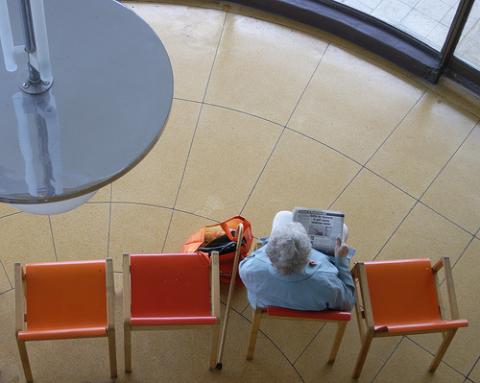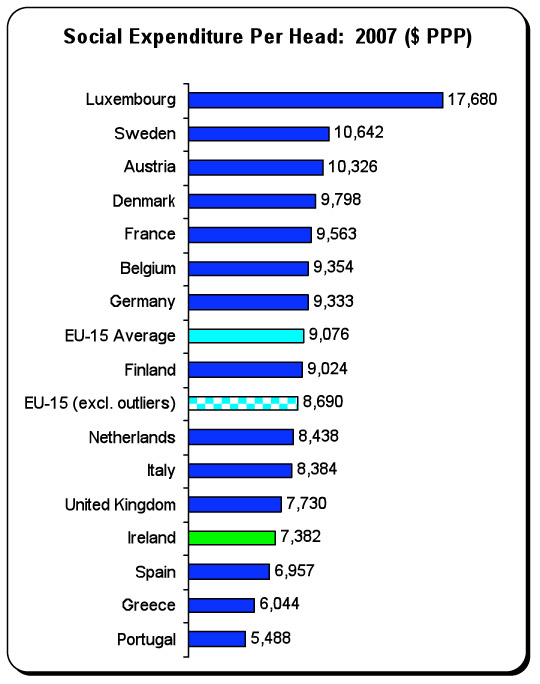Irish social expenditure - how do we compare?

In a previous post I pointed out that Ireland spends substantially less on public services per person than the average EU-15 country. For all the talk of a bloated public sector, we saw that in actual money terms, our public service resources are rather slim-line.
Let’s turn our attention to social expenditure – which the OECD defines as expenditure on: Old Age, Survivors, Incapacity-related Benefits, Health, Family, Active Labour Market Programmes, Unemployment, Housing, and Other social policy areas. This is a little less straightforward since much expenditure under this heading depends on demographics (e.g. age-related expenditure) and economic circumstances (e.g. unemployment). But let’s do up the table and examine any potential caveats.
 As seen, Irish social expenditure per head ranks low – 12th out of the EU-15. The OECD only provides data up to 2007 but this is useful – for this was our expenditure at our ‘richest’.
As seen, Irish social expenditure per head ranks low – 12th out of the EU-15. The OECD only provides data up to 2007 but this is useful – for this was our expenditure at our ‘richest’.
Irish social expenditure was 19 per cent below the EU-15 average (when we exclude the ‘outliers’ – Luxembourg and Portugal – it was 15 per cent below average).
So, in 2007 we would have had to increase social expenditure spending by, at the very least, approximately €4.5 billion just to reach the EU average. Given the cuts in the last two years, we can only guess how far behind we have fallen.
But now for the caveats. Such statistics are usually dismissed out-of-hand by referring to the small number of elderly people here relative to the EU average. This is certainly a factor. A large number of elderly people will naturally drive up social expenditure on pensions. However, the total picture is not so clear-cut.
While Ireland has relatively few elderly people, we have a large number of young people – a fact which also necessitates increased social expenditure. Indeed, our dependency ratio is, when including both young and old, pretty much the same as the EU average. Young and old make up 47 per cent of the working population age in Ireland – the average for the EU-15 is 49.9 per cent. Merely saying we have fewer elderly people doesn’t fully explain the underlying social expenditure trends.
Another excuse made by apologists for low social spending is that, in 2007 anyway, Ireland had fewer people unemployed. Again, true, but only to a point. The Irish unemployment rate was 4.6 per cent in that year, and the average EU-15 unemployment rate was 7 percent; higher, yes, but not by as much as some commentators would have us believe.
And then there are other areas that should demand higher Irish social spending relative to other countries. For example, we have consistently suffered from high levels of low-pay. The low-pay incidence in other EU-15 countries, according to the OECD, was 14.5 per cent in 2007. In Ireland it was 22 per cent. Such a situation would surely have required higher ‘in-work’ benefits or social transfers. But, apart from Family Income Supplement, we don’t do in-work benefits
Whatever the swings and roundabouts, we would probably ultimately end up close to where we started; namely, that Ireland woefully under-spends on social expenditure just as it woefully under-spends on public services.
When the Minister for Finance sits down after his budget speech, after slashing even more from income support, public services and the public sector generally, just remember: he is hammering a sector that was never a high-flier in European terms. Anything but. Yet, it is the users of those services; the providers of those services; those reliant upon social transfers – they, we, are the ones who will pay for a crisis that has nothing to do with our spending levels.
Michael Taft blogs at Notes on the Front and is economic advisor for UNITE.
(Image top via fras1977 on Flickr)
